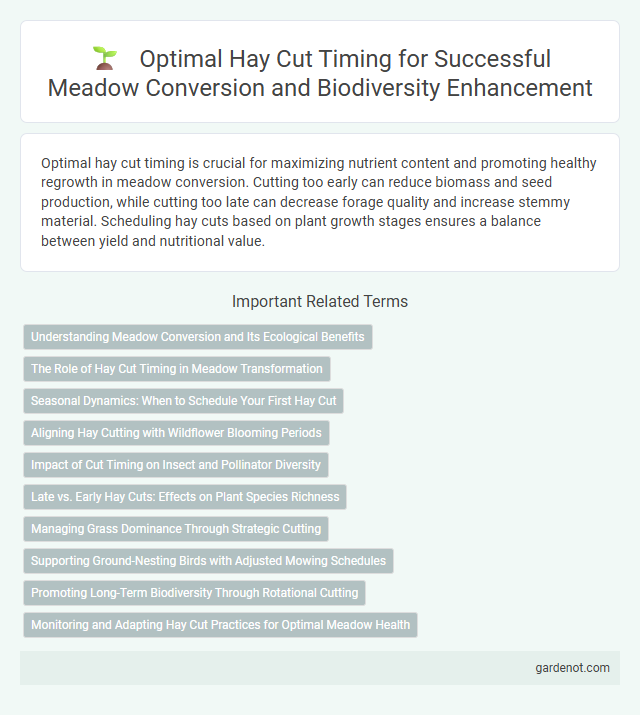Optimal hay cut timing is crucial for maximizing nutrient content and promoting healthy regrowth in meadow conversion. Cutting too early can reduce biomass and seed production, while cutting too late can decrease forage quality and increase stemmy material. Scheduling hay cuts based on plant growth stages ensures a balance between yield and nutritional value.
Understanding Meadow Conversion and Its Ecological Benefits
Hay cut timing plays a crucial role in meadow conversion by influencing plant biodiversity and habitat quality. Cutting hay after wildflowers have set seed supports ecological restoration and promotes a diverse array of pollinators and wildlife. Properly timed hay cuts enhance soil health and nutrient cycling, contributing to the long-term sustainability of meadow ecosystems.
The Role of Hay Cut Timing in Meadow Transformation
Hay cut timing critically influences meadow transformation by determining plant species composition and promoting biodiversity. Early cuts encourage nutrient-poor conditions favoring wildflowers and native grasses, while late cuts can increase soil fertility and support more competitive species. Optimizing hay cut timing enhances ecosystem services such as pollinator habitat and carbon sequestration in meadow ecosystems.
Seasonal Dynamics: When to Schedule Your First Hay Cut
Optimal hay cut timing hinges on understanding seasonal growth patterns and plant maturity stages in meadow ecosystems. Scheduling the first hay cut during late spring, typically between May and early June, aligns with peak nutrient content and biomass yield, ensuring high-quality forage. Monitoring local weather conditions and plant species phenology is crucial for timing that maximizes nutritional value and supports sustainable meadow management.
Aligning Hay Cutting with Wildflower Blooming Periods
Optimizing hay cut timing by aligning with wildflower blooming periods enhances biodiversity and supports pollinator populations. Cutting hay after peak wildflower bloom ensures seed dispersal and regeneration, fostering a diverse meadow ecosystem. Delayed cutting also maximizes forage quality while maintaining habitat for insects and ground-nesting birds.
Impact of Cut Timing on Insect and Pollinator Diversity
Hay cut timing directly influences insect and pollinator diversity by either disrupting life cycles or allowing habitat regeneration. Early cutting often reduces floral resources and nesting habitats, leading to lower populations of pollinators like bees and butterflies. Delaying cuts enhances plant diversity and supports a wider range of insects, promoting ecosystem health and improving pollination services.
Late vs. Early Hay Cuts: Effects on Plant Species Richness
Late hay cuts significantly enhance plant species richness by allowing wildflowers and grasses to complete their flowering and seed-setting cycles, promoting greater biodiversity. Early hay cuts often reduce species diversity by interrupting reproductive stages, favoring fast-growing grasses over delicate wildflowers. Research in meadow ecosystems consistently shows higher species richness and ecological resilience with delayed hay cutting practices.
Managing Grass Dominance Through Strategic Cutting
Strategic hay cut timing plays a crucial role in managing grass dominance within meadow ecosystems by reducing aggressive grass species' ability to outcompete wildflowers. Cutting hay at optimal growth stages limits grass seed production and promotes biodiversity by allowing a diverse range of plant species to flourish. Properly timed mowing fosters a balanced habitat, supporting pollinators and enhancing overall meadow health.
Supporting Ground-Nesting Birds with Adjusted Mowing Schedules
Adjusting hay cut timing to late July or early August provides critical support for ground-nesting birds by allowing sufficient nesting and fledging periods. Delayed mowing schedules help preserve bird habitats, reducing nest destruction and promoting higher breeding success rates. Implementing these practices aligns with conservation goals and enhances biodiversity within meadow ecosystems.
Promoting Long-Term Biodiversity Through Rotational Cutting
Rotational hay cutting schedules enhance long-term biodiversity by allowing diverse plant species to complete their life cycles, promoting habitat heterogeneity in meadows. Timing hay cuts to avoid peak flowering and seed dispersal stages supports the regeneration of native flora and sustains pollinator populations. Implementing a staggered cutting regime fosters resilient ecosystems and preserves valuable meadow biodiversity over multiple seasons.
Monitoring and Adapting Hay Cut Practices for Optimal Meadow Health
Monitoring hay cut timing through regular assessment of meadow growth stages ensures optimal regrowth and nutrient retention. Adjusting cut schedules based on seasonal weather patterns and plant species diversity promotes biodiversity and enhances soil health. Implementing adaptive hay cutting practices mitigates stress on native flora and supports long-term meadow ecosystem sustainability.
Hay cut timing Infographic

 gardenot.com
gardenot.com